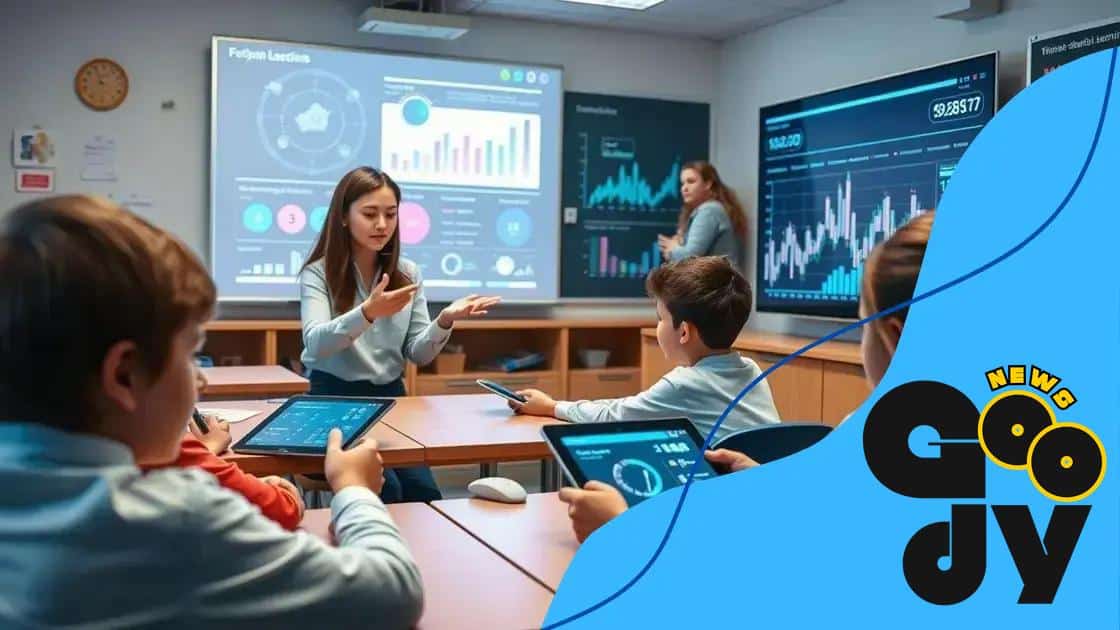AI for tracking student engagement: unlocking insights

AI for tracking student engagement personalizes learning experiences, enhances real-time feedback, and utilizes data analytics to improve educational outcomes while addressing challenges like data privacy and implementation costs.
AI for tracking student engagement is transforming education by helping teachers understand their students better. Imagine having insights into how engaged students are during lessons. This exploration reveals how AI can make a real difference in learning outcomes.
Understanding student engagement
Understanding student engagement is essential for improving learning outcomes. Engaged students are more likely to succeed in their studies. AI plays a crucial role in tracking how actively students participate in their learning experience.
When we think about student engagement, we imagine students who are interacting with their lessons, asking questions, and showing enthusiasm. This involvement can greatly influence their academic achievements. To measure this effectively, educators need reliable tools that can provide insights into student behavior.
Key Factors Influencing Engagement
Several key factors can determine how engaged a student is in the classroom:
- Interaction: Students who actively participate in discussions are often more engaged.
- Relevance: Lessons that connect to real-life scenarios tend to foster higher interest.
- Feedback: Timely feedback can keep students motivated and involved in their learning.
- Technology: Using modern tools, like AI, helps track engagement effectively.
Furthermore, engagement is not just about participation; it also involves emotional and cognitive investment. When students feel connected to the material, they are likely to put in more effort. Understanding these different aspects allows educators to tailor their teaching methods to better meet student needs.
AI allows educators to analyze patterns in engagement over time. By identifying when students are most or least engaged, teachers can adjust their strategies accordingly. For example, if many students disengage during a particular lesson, it may signal a need for a different approach.
Using AI to Decode Engagement
One of the most powerful benefits of AI in education is its ability to collect and analyze data. With these insights, educators can:
- Identify trends: Observe which activities lead to increased student interest.
- Tailor instructions: Provide customized lessons that fit learning preferences.
- Enhance communication: Foster better connections between students and teachers based on engagement data.
All of this information can help create a more engaging classroom environment. When teachers understand their students’ engagement levels, they can implement strategies that encourage participation. As a result, students may feel more motivated and excited about their education.
How AI tracks engagement effectively
How AI tracks engagement effectively is a pivotal topic in modern education. Technology allows us to gather valuable data that enhances the learning experience. By leveraging artificial intelligence, educators can monitor student interactions in real time.
One way AI tracks engagement is through analytics that assess student performance. It can analyze data from various sources, like quizzes and participation in class discussions. This means teachers get a clearer picture of how students are doing, allowing for timely interventions when necessary.
Methods of Tracking Engagement
There are several effective methods AI uses to track engagement:
- Data collection: AI systems gather data on students’ activities, such as time spent on tasks and completion rates.
- Behavior analysis: By understanding how students interact with materials, AI can identify engagement levels.
- Real-time feedback: Students receive immediate responses on their work, which encourages them to stay engaged.
- Learning pathways: AI can suggest personalized learning experiences based on individual engagement data.
Moreover, AI can utilize machine learning algorithms to predict which students might struggle based on their engagement patterns. For example, if a student is frequently disengaged, the system can alert the teacher to provide additional support. This proactive approach not only helps at-risk students but also enhances overall classroom dynamics.
Many educational tools now incorporate AI capabilities, making it easier for teachers to track student engagement. With dashboards displaying relevant metrics, teachers can quickly see how their students are performing. They can adjust their teaching methods based on what the data reveals.
Benefits of AI Tracking
The benefits of using AI for tracking engagement are substantial. Schools can:
- Improve retention: Understanding when students disengage can help to develop strategies to keep them motivated.
- Enhance learning experiences: Data-driven insights allow for a more tailored approach.
- Facilitate teacher effectiveness: With AI tracking, teachers have access to valuable information that informs their practices.
As technology evolves, the relationship between AI and engagement will continue to grow deeper, changing how education is delivered and experienced in the classroom.
Benefits of AI in education

The benefits of AI in education are substantial and are reshaping how students learn. By integrating AI technology, schools can enhance teaching and learning processes significantly.
AI can help personalize education for each student. With tailored learning experiences, students receive support based on their individual needs. For instance, AI systems can analyze a student’s performance and adapt the curriculum accordingly. This means that if a student struggles with a specific topic, AI can offer additional resources and exercises to aid understanding.
Key Advantages of AI in the Classroom
Several key advantages demonstrate how AI positively impacts the educational environment:
- Efficiency: AI can automate administrative tasks, allowing teachers to focus more on teaching.
- Engagement: Interactive AI tools can make learning more enjoyable, encouraging active participation.
- Real-time feedback: Students receive instant feedback on their performance, helping them improve rapidly.
- Data analysis: AI can track trends over time, providing insights into student behavior and learning patterns.
Additionally, AI aids in identifying students who may need extra help. By analyzing engagement and performance metrics, it becomes easier to provide timely support. This approach allows educators to intervene early, which can lead to better learning outcomes.
Using AI-driven tools also facilitates better communication between teachers and students. Features like chatbots can answer common questions, freeing up teacher time for more meaningful interactions. Students can get help anytime, which supports their learning journey.
Enhancing Administrative Tasks
One of the biggest improvements AI brings to education is in simplifying administrative tasks. Tasks such as grading exams and processing paperwork can be streamlined. This efficiency means that educators spend less time on administrative work and more time on instruction.
Moreover, AI can also help in developing lesson plans. It can analyze what works best based on student performance and suggest modifications accordingly. This proactive approach leads to more effective teaching strategies.
Overall, the integration of AI in education leads to a more engaging, efficient, and personalized learning experience. As technology continues to advance, these benefits will only grow, opening new opportunities for students and educators alike.
Challenges and limitations of AI tools
The challenges and limitations of AI tools in education are important topics to discuss. While AI offers numerous benefits, it is not without its problems, and understanding these issues is crucial for effective implementation.
One major challenge is the cost of AI technology. Schools, especially those with limited budgets, may find it difficult to invest in advanced AI tools and infrastructure. This financial barrier can prevent them from accessing the full potential of AI in enhancing learning experiences.
Data Privacy Concerns
Another significant issue revolves around data privacy. AI tools often rely on large amounts of student data to function effectively. This raises concerns about how data is collected, stored, and used. Parents and schools may worry about the potential for misuse of sensitive information. Ensuring data security and compliance with regulations is essential for building trust.
Additionally, AI systems can be biased if they are trained on incomplete or unrepresentative data. When AI tools reflect these biases, they can lead to unfair treatment of students. For example, an AI tool that assumes certain learning styles may disadvantage students who don’t fit those profiles.
Technical Limitations
The technical limitations of AI tools can also hinder their effectiveness. Many AI systems require stable internet connections and frequent updates to function optimally. In areas where such connectivity is unreliable, using AI tools can become challenging. This issue can create disparities in access to quality education.
Moreover, training teachers to effectively use AI tools can be time-consuming and requires ongoing support. Educators need professional development to feel comfortable with these technologies. Without proper training, the tools may not be utilized effectively, which can lead to poor outcomes.
Finally, while AI can enhance learning, it should never replace the human element of teaching. The relationships between students and educators are vital for effective learning. Over-reliance on AI tools could diminish personal interactions, which are crucial for student engagement and success.
Future trends in educational AI
Future trends in educational AI point to exciting advancements that could significantly enhance learning experiences. As technology continues to evolve, we can expect AI to play an increasingly vital role in education.
One of the key trends is the rise of adaptive learning technologies. These systems use AI to personalize education for each student by analyzing their strengths and weaknesses. As a result, educational content can be tailored to meet individual needs, helping students learn more effectively.
Increased Use of Data Analytics
In the future, the use of data analytics in education will grow. AI will process vast amounts of data to identify patterns in student behavior and performance. This information can help educators make informed decisions about curriculum adjustments and teaching methods. Schools will be better equipped to understand how students learn, which can lead to improved outcomes.
Moreover, the integration of AI-powered chatbots into learning platforms will create a more interactive learning environment. These chatbots can provide instant support for students, answer questions, and offer additional learning resources. This shift will encourage student engagement and make learning more accessible.
Enhanced Virtual Reality Learning
Another area to watch is virtual reality (VR). As VR technology advances, it will likely become an integral part of education. AI can enhance VR environments to create immersive learning experiences. Students will be able to explore complex subjects through simulations, making learning both engaging and effective.
Furthermore, we can anticipate AI-driven tools that help teachers develop interactive lesson plans and assessments. These tools will suggest activities and resources based on student needs and learning objectives. This capability allows for more flexible teaching methods that can adapt to various learning environments.
Collaboration Between AI and Educators
The future will also see a stronger collaboration between AI and educators. Rather than replacing teachers, AI will serve as a valuable assistant. Teachers will use AI insights to enhance their teaching approaches while maintaining the critical human element of education.
By embracing these trends, educational institutions can prepare for a future where AI significantly enhances the learning process. This evolution promises not only to improve student outcomes but also to make education more engaging and personalized.
In conclusion, the future of AI in education holds great promise. As we embrace new technologies, we can expect personalized learning experiences that engage students better than ever. While there are challenges to address, such as data privacy and bias, the benefits of AI far outweigh the drawbacks. By collaborating with educators, AI can enhance teaching methods and provide students with the support they need to succeed. As we move forward, continuous innovation will ensure that AI remains a valuable asset in the classroom.
FAQ – Frequently Asked Questions about AI in Education
What is the role of AI in personalized learning?
AI adapts educational content to meet individual student needs, helping to improve their learning outcomes.
How can data analytics benefit schools?
Data analytics helps schools identify trends in student performance, allowing for informed decisions that can enhance teaching strategies.
What are AI chatbots and how do they assist students?
AI chatbots provide instant answers to students’ questions, making it easier for them to access help whenever they need it.
What challenges do schools face when implementing AI tools?
Schools may encounter issues such as budgeting constraints, data privacy concerns, and training needs for teachers to effectively use AI technologies.





